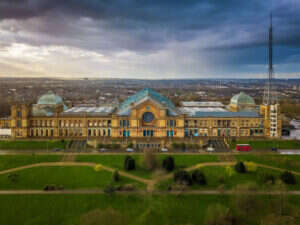It’s finally happened: China’s central government has realised that some of the wild and wonderful structures erected around the country are a little, well, odd.
China is famed both for its identikit copies of Western landmarks (there are four times as many Eiffel towers in China as there are in France) and its strangely shaped buildings, like the circular one in Guangzhou shown above. At the end of last year, China’s president, Xi Jinping, called for less “weird” architecture in Chinese cities.
Now, the country’s State Council has backed up his request with a whole new urban blueprint for the country, based on meetings held in December. According to the South China Morning Post, the resultant document demands that architecture in cities be “suitable, economic, green, and pleasing to the eye”, rather than “oversized, xenocentric, [and] weird.”
Xenocentrism (which has been translated as “West-leaning” in other commentary on the document) usually means “an obsession with cultures that aren’t your own”, and is an issue for a nation which is hoping to make its own mark on the world – not indulge entire copies of Western cities as its tourist attractions.
The President said that the prevalence of buildings without Chinese cultural heritage show “a lack of cultural confidence and some city officials’ distorted attitudes about political achievements.”
Less excitingly, the report also spoke out against gated communities – no more are to be built, and already existing ones will be gradually opened to the public.
The directive as a whole seems aimed at controlling China’s rapid urbanisation, which has, at times, lacked regulation and an overall plan. The country’s giant ghost towns and cities are symptoms of over-rapid development, while nail houses (homes marked for demolition whose tenants refuse to be evicted) demonstrate the human cost of bulldozer-centric urbanisation.
It’s telling that the last set of meetings comparable to those held in December happened in 1978. Since then, the country has urbanised rapidly, and now over 50 per cent of residents live in cities:
Without a full translation it’s hard to tell, but it does seem the directive is more concerned with the aesthetics and reputation of buildings, rather than their usefulness for China’s residents. Let’s hope it isn’t all talk and no trousers.
Oh, and while we’re on the subject, we’ll leave you with Suzou’s “pair of trousers” building, also known as the Gate of the East:
Image: Christian Gänshirt via Wikimedia Commons.
Enjoy the lols while you still can.







